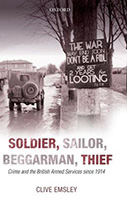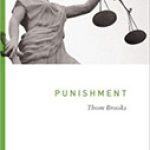Soldier, Sailor, Beggarman, Thief: Crime and the British Armed Services Since 1914

Author: Clive Emsley
Publisher: Oxford: Oxford University Press, 2013. 256p.
Reviewer: Georgina Sinclair | January 2014
The recent court martial verdict of ‘Marine A’, the British soldier convicted of the murder of a Taliban fighter while on patrol in Helmand in September 2011, has raised challenging questions about crime and the armed services. ‘Marine A’ is the first British serviceman to be convicted of ‘murder’ in either of the Iraq or Afghanistan conflicts. Murder is a form of criminal homicide and is neither justifiable nor excusable. Many senior British army officers have called for ‘Marine A’ to receive severe punishment for a crime where he openly accepted that the Geneva Convention had been broken. Indeed there may now be a proliferation of cases in which the Ministry of Defence and the Armed Services are held up by the courts for their failure to correctly observe an article of the European Convention on Human Rights, and in particular Article 2, ‘the right to life’. ‘Crime is one element of any society’ notes Clive Emsley in this his most recent book, and criminal activities amongst the armed forces remains an under-researched area. The book opens the door to this topic, addressing the complexities of crime and the armed services, military law and the tensions it creates with civilian law. The text is broadly divided into three core sections: an analysis of the criminal justice system of the armed forces from 1900 to 1950; criminal activities undertaken during the First and Second World Wars, and, finally moving post 1945 to the present day.
This book offers excellent coverage of ‘ordinary decent crime’ alongside more serious offences. Emsley notes that crime was committed by an ‘enormous number of men’ in the armed services, whose numbers rose substantially from 1916-1919, and then from 1940 to 1961, as a result of conscription, and then national service. Most people accused of crime in the twentieth century were young men, and they may have brought their ‘tradition of offending’ with them. There are interesting statistics used relating to the changes in the types of criminal convictions between the First and Second World Wars, and, the offences deemed sufficiently important to bring before the courts; the majority of courts martial dealt with offences committed against military law. For example, there were 29,975 cases of ‘threatening, insubordinate language’ during the First World War, but only 5,263 cases during the Second World War — suggestive of a ‘less rigid approach to discipline’. ‘Theft’ however, was a different matter, with 18,599 cases reported during the Second World War and 9,322 during the First World War. Theft and the handling of stolen goods were the most common categories of offence within civilian criminal statistics during the twentieth century, representing two thirds of recorded crimes. British soldiers were once described as ‘the biggest thieves in the world’ — which Emsley tempers by illustrating the opportunities that war presented through the appropriation of any type of goods from military stores, the black market, looting and corruption. Evidently ‘theft’ was not just the preserve of the ordinary soldier. The most senior of ranks indulged at times and Emsley quotes a disgusted contemporary who recorded: ‘One Air Marshal, who was knighted, collected yachts near Schleswig and sent them back to members of the Cabinet’.
Wartime criminal activities (aside from theft) also included thornier issues including desertion (which was a capital offence during the First World War), absenteeism and mutiny. Mutinies, which Emsley likens to ‘modern labour disputes and strikes’ were probably triggered by the pressures of service life and ‘the insistence that the soldier, sailor, or airman obey a superior without question.’ There were 1,807 reported cases during the First World War, and 800 during the Second World War. The military could respond leniently and so, for example the refusal to parade during the First World War, was typically dealt with without recourse to a charge of mutiny, and attempts were made to listen to soldiers’ grievances. ‘Real’ mutiny could be extremely serious and result in violence and fatalities as occurred during an attack on the Epsom Police Station and at Kinmel Camp in 1919. The end of the First World War brought serious unrest when conscripted soldiers became disgruntled with the demobilisation process, whilst others were alarmed at their deployment to a new conflict in Russia.
The ‘coexistence of military and civilian law provided the potential for confusion and friction’ which could result in the use of informal systems of justice and so-called ‘unwritten law’. The early chapters here deal with the similarities and differences between civilian and military law and how this could be reconciled. British military law like English criminal law has never been simply codified and its application was complicated by the situation of the offender during the act (on active duty or not), and by the scene of the offence (overseas and some distance from a British court or in the UK). The tensions between military and civil law (particularly in relation to military discipline) were further exacerbated when a conscripted serviceman challenged the letter of military law thus potentially clashing with a regular service superior. Whilst the information about the background of a military offender is not always available, there are many useful examples provided throughout this book. Jim Carradice, conscripted into the Gordon Highlanders in the Second World War, was highly dismissive of the senior NCOs in his regiment and this feeling was mutual. Matters came to a head when Carradice refused a promotion and ‘within minutes of his refusal’ was charged with being improperly dressed; subsequently followed by further disciplinary charges for the use of obscene language and refusing instructions. The Commanding Officer decided to mete out a suitable ‘military’ punishment (this could include confinement to barracks) which Carradice refused, stating that he had the right to a court martial, which he received. In the event the court, in upholding the rules of evidence, found him not guilty. Despite declining to bring a charge of ‘discrimination’ against the NCOs, he remained unpopular with senior officers, transferring to the Argyll and Sutherland Highlanders.
Violent crimes committed by a member of the armed forces during wartime occurred for many reasons, including a property theft or looting that backfired, and ‘culture clashes’ between two servicemen. War also brought out the darker sides to crime and Emsley discusses how personal vendettas could lead to ‘the confusion of battle provid[ing] the opportunity for the perfect murder to be committed ….’ ‘Interpersonal violence included a range of sexual offences including rape (the charge sometimes brought as a result of sexual intercourse with a minor) and gross indecency with minors (coercion of boys) which was dealt with vigorously by the armed forces. Emsley does not shy away from the fact that ‘soldiers committed rape’ and that whilst during the Second World War rape by members of the British armed forces seems to have been rare, the reverse appears true of some imperial troops and US servicemen – though there was nothing on the scale of the rape by the Russian Army in Germany. Domestic violence though, was one area where a system of ‘informal justice’ and ‘unwritten law’ might prevail and the serviceman might avoid capital punishment. War and military service caused the separation of individuals and long term disruption to normal family life. Wives and girlfriends might seek out new partners which impacted upon the emotional well-being of service personnel. Driver Edward Jones, for example, came home on leave unannounced in 1945 to find that his wife had taken their two children and moved in with another man. Jones returned to the front, but on learning from his wife that she intended to remain with her new partner, he was granted compassionate leave home (this was often given in these circumstances) and killed his rival with a Sten gun. It took the jury a mere twenty minutes to find Jones ‘not guilty’ of murder but of manslaughter. The judge agreed with their verdict stating ‘in view of [your] good character … and the tragic circumstances of your own life, for which you are in no way to blame….’ Jones was bound over for two years and ordered to pay £5. A range of case studies demonstrate how military courts would sometimes push the legal boundaries to ensure that a soldier was convicted on a lesser charge; thus the offence of murder might be reduced to ‘manslaughter under great provocation’.
Throughout this absorbing analysis of crime and the armed forces emerge new areas for future research in this field. This includes the evolving role of the Military Police (MP) and their Special Investigation Branch (SIB) and their role in the application of military law, and development of their close working relationship with the civilian police, the armed forces and other influential institutions. SIB (sometimes in association with the Metropolitan Police) investigated theft from army stores and looting as well as more serious offences. The book also addresses the issue of women service personnel and crime. During the Second World War women were appointed to the services police as a result of the significant recruitment of women into the armed forces. In the main crimes centred on absenteeism and disciplinary offences which the ATS Military Provost noted as ‘include[ing] almost anything, drunkenness, wearing your stockings (they looked shinier and more transparent) inside out, smoking with your cap on in the street, wearing your cap indoors, and going arm in arm with a soldier’…
The author deals with such controversial subjects as the extent to which battlefield stress and post-traumatic stress disorder can be attributed to criminal behaviour (often when a soldier has returned home). He tackles the historical evidence relating to what was first described as ‘shell shock’ defence of criminal behaviour and the extent to which informal systems of justice were applied by military courts as a result. There were instances, he notes, in the aftermath of the First World War when convictions for murder committed by ex-servicemen resulted in the perpetrator being declared unfit to stand trial. However, the ‘shell shock’ or ‘barbed wire’ (prisoner of war) syndrome was not always brought forward as a defence. Sometimes the concept of having been a ‘graduate of the school of war’ sufficed as a reason for mitigating circumstances. Although war might present an opportunity for criminal activity, it is clear from the survey that a large number of conscripts would not ordinarily have found themselves subjected to military discipline.
Post 1945 did not bring an end to the types of crime witnessed during the two world wars. The Cold War years saw large numbers of conscripted servicemen deployed overseas to colonial hotspots including Palestine, Malaya and Kenya, as well as to the conflict in Korea where the same types of crimes were committed. The real changes that took place during this period were to the justice systems of the services as they continued to move closer to their civilian counterparts, ironing out some of the earlier tensions and reflecting broader changes within British society. Military courts (courts martial), for example, developed greater awareness of the need to examine the character of the soldier accused, the circumstances surrounding an incident and to take into consideration that person’s previous behaviour. Much later, in 2006, the Armed Forces Act saw the creation of the Service Prosecuting Authority headed by a civilian QC to deal with cases for the three armed forces. This may be timely with current debates on the impact of military training and war on an individual’s possible behaviour. In a final chapter, Emsley reflects on these issues including the reasons why large numbers of former servicemen have ended up in prison, have committed suicide or acts of violent crime, raising the question of ‘offender’ or ‘victim’? The complex topics addressed throughout this book are well-informed and meticulously researched. This book is to be welcomed by academics, legal and military practitioners alike, as well as those new to the area.
Georgina Sinclair, Ph.D., Research Fellow in the History Department, Open University. Associate Investigator with the ARC Centre of Excellence in Policing and Security


